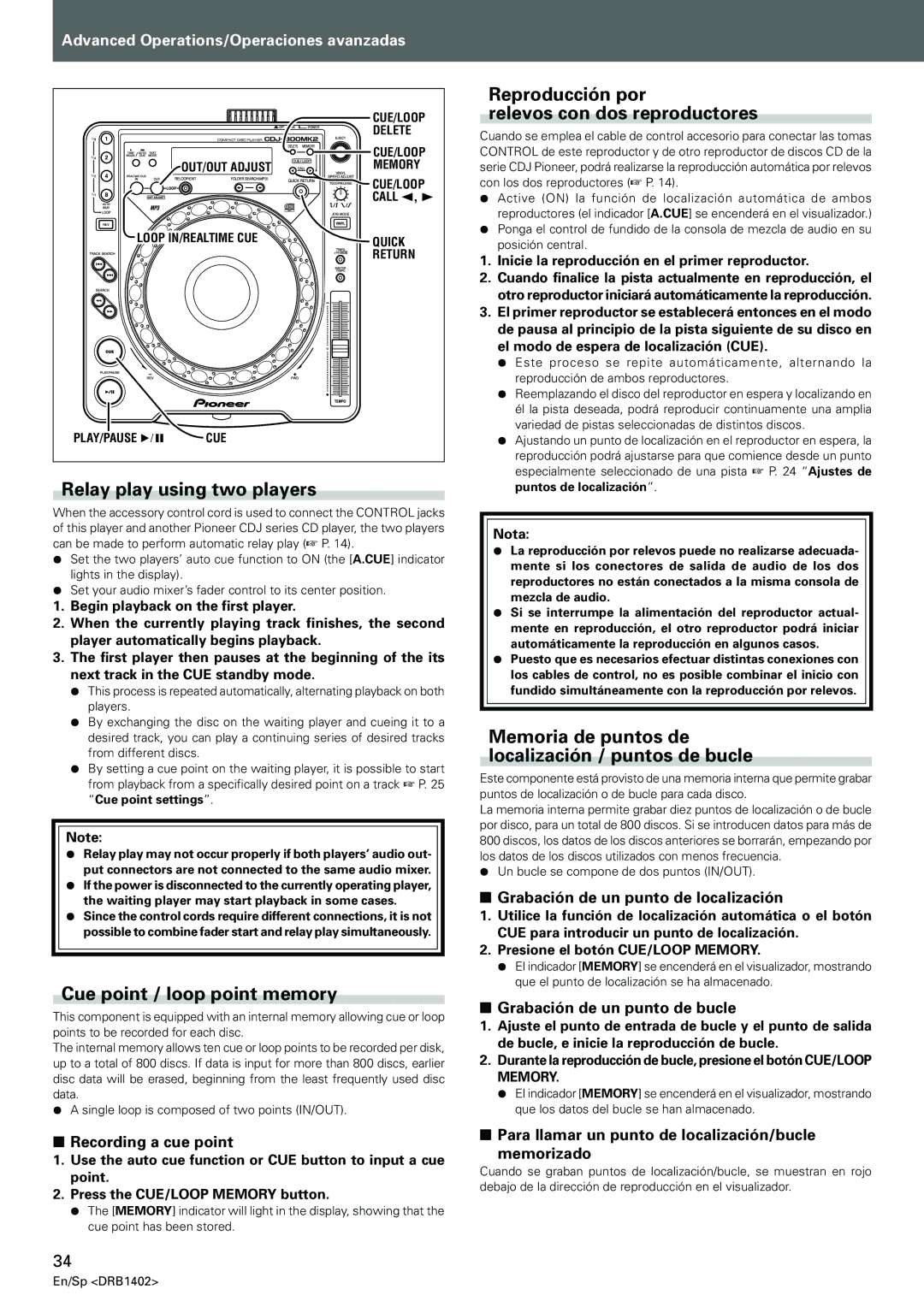Advanced Operations/Operaciones avanzadas
| CUE/LOOP |
| DELETE |
| CUE/LOOP |
OUT/OUT ADJUST | MEMORY |
| CUE/LOOP |
| CALL 2, 3 |
LOOP IN/REALTIME CUE | QUICK |
| RETURN |
Relay play using two players
When the accessory control cord is used to connect the CONTROL jacks of this player and another Pioneer CDJ series CD player, the two players can be made to perform automatic relay play (☞ P. 14).
¶Set the two players’ auto cue function to ON (the [A.CUE] indicator lights in the display).
¶Set your audio mixer’s fader control to its center position.
1.Begin playback on the first player.
2.When the currently playing track finishes, the second player automatically begins playback.
3.The first player then pauses at the beginning of the its next track in the CUE standby mode.
¶This process is repeated automatically, alternating playback on both players.
¶By exchanging the disc on the waiting player and cueing it to a desired track, you can play a continuing series of desired tracks from different discs.
¶By setting a cue point on the waiting player, it is possible to start from playback from a specifically desired point on a track ☞ P. 25 “Cue point settings”.
Note:
¶Relay play may not occur properly if both players’ audio out- put connectors are not connected to the same audio mixer.
¶If the power is disconnected to the currently operating player, the waiting player may start playback in some cases.
¶Since the control cords require different connections, it is not possible to combine fader start and relay play simultaneously.
Cue point / loop point memory
This component is equipped with an internal memory allowing cue or loop points to be recorded for each disc.
The internal memory allows ten cue or loop points to be recorded per disk, up to a total of 800 discs. If data is input for more than 800 discs, earlier disc data will be erased, beginning from the least frequently used disc data.
¶A single loop is composed of two points (IN/OUT).
■Recording a cue point
1.Use the auto cue function or CUE button to input a cue point.
2.Press the CUE/LOOP MEMORY button.
¶The [MEMORY] indicator will light in the display, showing that the cue point has been stored.
34
Reproducción por
relevos con dos reproductores
Cuando se emplea el cable de control accesorio para conectar las tomas CONTROL de este reproductor y de otro reproductor de discos CD de la serie CDJ Pioneer, podrá realizarse la reproducción automática por relevos con los dos reproductores (☞ P. 14).
¶Active (ON) la función de localización automática de ambos reproductores (el indicador [A.CUE] se encenderá en el visualizador.)
¶Ponga el control de fundido de la consola de mezcla de audio en su posición central.
1.Inicie la reproducción en el primer reproductor.
2.Cuando finalice la pista actualmente en reproducción, el otro reproductor iniciará automáticamente la reproducción.
3.El primer reproductor se establecerá entonces en el modo de pausa al principio de la pista siguiente de su disco en el modo de espera de localización (CUE).
¶Este proceso se repite automáticamente, alternando la reproducción de ambos reproductores.
¶Reemplazando el disco del reproductor en espera y localizando en él la pista deseada, podrá reproducir continuamente una amplia variedad de pistas seleccionadas de distintos discos.
¶Ajustando un punto de localización en el reproductor en espera, la reproducción podrá ajustarse para que comience desde un punto especialmente seleccionado de una pista ☞ P. 24 “Ajustes de puntos de localización”.
Nota:
¶La reproducción por relevos puede no realizarse adecuada- mente si los conectores de salida de audio de los dos reproductores no están conectados a la misma consola de mezcla de audio.
¶Si se interrumpe la alimentación del reproductor actual- mente en reproducción, el otro reproductor podrá iniciar automáticamente la reproducción en algunos casos.
¶Puesto que es necesarios efectuar distintas conexiones con los cables de control, no es posible combinar el inicio con fundido simultáneamente con la reproducción por relevos.
Memoria de puntos de localización / puntos de bucle
Este componente está provisto de una memoria interna que permite grabar puntos de localización o de bucle para cada disco.
La memoria interna permite grabar diez puntos de localización o de bucle por disco, para un total de 800 discos. Si se introducen datos para más de 800 discos, los datos de los discos anteriores se borrarán, empezando por los datos de los discos utilizados con menos frecuencia.
¶Un bucle se compone de dos puntos (IN/OUT).
■Grabación de un punto de localización
1.Utilice la función de localización automática o el botón CUE para introducir un punto de localización.
2.Presione el botón CUE/LOOP MEMORY.
¶El indicador [MEMORY] se encenderá en el visualizador, mostrando que el punto de localización se ha almacenado.
■Grabación de un punto de bucle
1.Ajuste el punto de entrada de bucle y el punto de salida de bucle, e inicie la reproducción de bucle.
2.Durante la reproducción de bucle, presione el botón CUE/LOOP MEMORY.
¶El indicador [MEMORY] se encenderá en el visualizador, mostrando que los datos del bucle se han almacenado.
■Para llamar un punto de localización/bucle
memorizado
Cuando se graban puntos de localización/bucle, se muestran en rojo debajo de la dirección de reproducción en el visualizador.

